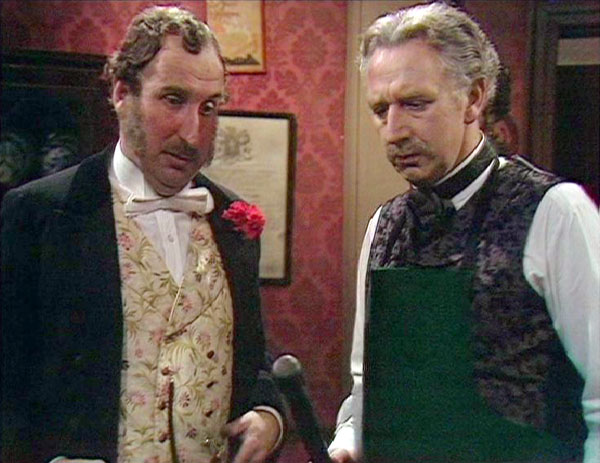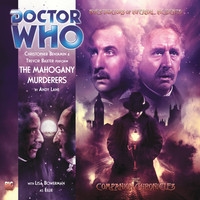See Part One and Part Two
Minor spoilers ahead.
Right around the same time as the release of Series 5 of Jago and Litefoot, the duo guest starred in a Big Finish Doctor Who story featuring Tom Baker as the Doctor with Mary Tamm as his companion Romana.
The story is kind of a Victorian version of Judge Dredd meets Superman as a steampunk cyborg vigilante delivers swift vengeance to evildoers on the streets of London. It’s a great yarn but Jago and Litefoot are pretty much in sidekick roles.
Series Six came out in the fall of 2013 and sees them returning to their best form as they encounter the mysterious Colonel who has some business for them to do on behalf of the crown.
The series gets back to its Victorian roots with, “The Skeleton Quay,” where they go to investigate a series of murders off the coast of Shingle Cove. The atmosphere on this is perfect and the plotline is very well-written. It’s probably the most authentically Victorian story Jago and Litefoot have done.
It does feature Jago and Litefoot conveniently forgetting their time in the 1960s and their travels in the TARDIS to Venus for no explicable reason and concluding it was a dream. It’s a case of plot and writer convenience. The experiences, if retained, would probably change the characters too much so I understand why they did it. However, that being the case, Jago and Litefoot shouldn’t have gone there or they should have come up with a more explicable explanation for what happened.
Next up is, “Return of the Repressed” which has Jago and Litefoot meeting up with Sigmund Freud in a nice psychological drama. The story begins with Jago telling Freud of his dreams and then those dreams end up coming to life.
The story has some great humorous moments and for once, Professor Litefoot provides them. At the same, it provides some insight into Jago and Litefoot’s characters. It’s brilliantly written and a lot of fun.
In “Military Intelligence,” the mysterious Colonel, who called Jago & Litefoot into service for the crown at the beginning of the sixth series wants information regarding their encounters with Doctor Tulp who they battled in the “Mahogany Murderers” and during Series One of Jago & Litefoot. However, Litefoot smells a rat. A s he asks questions, the situation gets more dangerous.
The story is exciting and packed full of intrigue, mystery, steampunk elements, and a surprise guest character all leading to an ending that sets up the Series finale beautifully.
In, “The Trial of George Litefoot,” Litefoot is arrested for the murder of Jago. The idea for the plot was an intriguing one, but in the first half they strained credulity far too much. It seemed like they were concerned about laying the groundwork for the premise of Series Seven that they cut a lot of corners to get there. At fifty-three minutes, the story could have benefited from being a bit longer to fill in the gaps of logic.
However, the last twenty minutes has the story back on track with our heroes having a thrilling climatic battle with the Colonel, who has an utterly insane plan to bring down the British empire. Overall, it is a decent conclusion to Series Six.
As a whole, Series Six re-established the series’ original premise and sets the stage for Series Seven which would have Jago and Litefoot on the run and wanted.
Series Seven begins with, “The Monstrous Menagerie,” which finds Jago and Litefoot in disguise as Sherlock Holmes and Doctor Watson and sent out on a case by none other than Arthur Conan Doyle (played by Steven Miller) himself.
The story is set after Doyle’s killed off Holmes in “The Final Problem” and finds the author encountering constant cries from fans to bring Holmes back. Miller does a great job in the story and Jonathan Morris’ script does a great job playing up Doyle’s frustration.
There are some great hints and references to future Doyle stories including, “The Hound of the Baskervilles” and “The Lost World.” This is a very delightful, well-acted tale and the strongest opening to a Jago and Litefoot box set since Series One.
While the previous Series’ “Return of the Repressed” took a somewhat lighthearted look at the psychology of our heroes, Series 7’s “Night of 1,000 Stars,” examines Jago, Litefoot, Ellie, and Leela (who has appeared for a reason that’s key to the story).
It’s meaty material that has our heroes questioning which of them is behind their predicament and they come to the conclusion that one of them is in fact a killer. It’s a clever script that could easily be performed as a stage play. It’s a fantastic script that shows that there’s still a lot more depths to plumb with these characters.
Murder at Moorsey Manor features Jago and Litefoot showing up at a mansion for a party under assumed names to speak to a key witness who can clear them. However, they find out that they’re at an early convention. Then they and the other guests discover that they’re in an old house where one person dies every hour. Murder at Moorsey Manor is evocative of, “And Then There Were None…” and other “old house” murder stories.
The story moves at a good pace and manages to blend suspense with comedy in a way that is seamless. The finale and solution to the case are superb and cleverly executed. The story concludes with them apparently arrested.
However, in the series finale, “The Wax Princess,” Jago and Litefoot, to their surprise, find themselves not under arrest. Instead, they learn Jack the Ripper was captured by Inspector Abeline but he’s escaped and it’s up to them to find him.
The story works. There are some great suspenseful moments, a strong performance for Sergeant Quick, a nice bit of misdirection over the identity of the Ripper, and even a somewhat funny bit where Lightfoot impersonated Jago.
The story wasn’t perfect. The whole premise of the box set was dealt with and dismissed rather quickly. “Forget about that whole being on the run thing, the police need you to hunt Jack the Ripper.” Also, I have to admit the realization of Queen Victoria was a little weak. Having the actress who played her talking in a very high falsetto seemed a bit below the typical standards of the series, although she still managed some good moments even with that voice.
Overall, though this was an enjoyable conclusion to one of the best series of Jago and Litefoot.
Between Series Seven and Eight, Big Finish released, “The Worlds of Doctor Who,” a good marketing idea that featured a story that would feature episodes from three Doctor Who spin off ranges and then a Doctor Who episode with Colin Baker’s Sixth Doctor. The four stories would be inter-linked by the same villain operating in different times and places.
Jago and Litefoot are in the lead off story, “Mind Games,” where the duo look into a series of murders in London when they find a man who dreamed he committed the murder and another is awakened before following through. The clues point back to a hypnotist named Mr. Rees. Overall, this was unremarkable Jago & Lightfoot fare. Our heroes provide charm but little else. The story’s problems may stem from the fact it’s the start of a storyline that would be picked up 3/4 of a century later.
They do make a cameo appearance in the third story for UNIT, “The Screaming Skull,” via a recording done on a wax cylinder. It’s a nice touch and Big Finish did a great job treating the audio so it sounded like an authentic wax record from the late 19th or early 20th centuries.
In the fall of 2014, Jago and Litefoot Series 8 was released and it was a bit of a departure from most of the recent box sets. Usually, at least three of the four stories are interconnected, starting with the first episode. However, in this set, the first and second stories are standalone tales and the final two episodes are essentially a two parter.
The set kicks off with Jago deciding to hire a puppet act in, “Encore of the Scorchies.” Little does Jago know the Scorchies are evil alien puppets (from a Doctor Who audio in which they were the titular characters.) It doesn’t take long before those evil killer puppets are up to their old tricks as they get hired on to perform at Jago’s theater and the result is mayhem.
The episode is full of superbly written musical numbers and are performed brilliantly with some very good guest vocalists as well as a couple of strong numbers from Jago and Ellie. The Encore of the Scorchies has some very funny scenes, most notably the one where the Scorchies expected to blow Lightfoot’s mind by explaining they were evil aliens bent on world domination and found him unimpressed, plus the final scene for Ellie has a great humorous twist.
At the same time, the story never loses sight of the genuine horror of what the Scorchies are doing and it how it effects the characters in the story, which manages to give it a neat balance. Overall, this was a very memorable start to the series.
“The Backwards Men,” has Jago and Litefoot looking into mysterious deaths that center around Wednesday’s World of Weird Wonders. It marks the return of Andy Lane who wrote the Mahogany Murderers but hadn’t written for the series since Series Three. The story has a lot of fun touches that seem quite true to the Victorian era . The story features an extra-terrestrial element including an alien symbiote that’s not everything he seems to be.
The villain was given an interesting backstory and motive. The final few minutes were riveting with Jago fighting for his life and mind.
“Jago, Litefoot, and Patsy,” introduces the Mudlark Patsy, who discovers a fish with a man’s severed hand in it. This leads to her foisting herself on Jago and Litefoot as she wants the fish back when the investigation is done. Through the course of the story, she’s given an interesting backstory as the Queen of Jacob’s Island.
This one is solidly atmospheric with Flaminia Cinque turning in a solid performance as Patsy and the story maintaining some great Victorian atmosphere and a well-done final confrontation and a final scene that set up the box set’s finale.
“Higdson and Quick,” is a very different finale that finds something very wrong with our heroes and it’s up to Ellie and Inspector Quick to save the day.
At the core of the story is the idea of Jago and Litefoot being under an alien influence but it not changing their personality. It’s very well acted by the two leads. The whole plot is fascinating, and it features well-realized scenes on a train.
Series Eight left our heroes quite beleaguered and emotionally drained and ends with them deciding to recharge by taking cruise expecting nothing eventful at all to happen, but they’d learn better in Series Nine, which we’ll discuss next week.
This post contains affiliate links, which means that items purchased from these links may result in a commission being paid to the author of this post at no extra cost to the purchaser..
If you enjoyed this post, you can have new posts about Detective stories and the golden age of radio and television delivered automatically to your Kindle.


